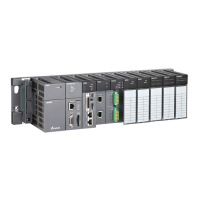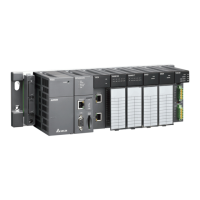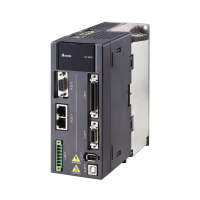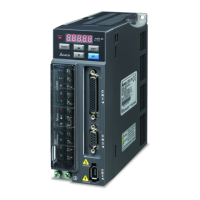AH500 Programming Manual
6-490
b15
b0
b7 b8
0016#
S1
16#31(1)
16#32(2)
33(3)16# 34(4)16#
36(6)16#
35(5)16#
37(7)16#
38(8)16#
39(9)16#
b15
b0
b7 b8
D
+1
D
+1
S1
+2
S1
+3
S1
+4
S1
S2
S3
+5 S1
30(0)16#
10
3
16#31(1) 32(2)16#
000016#
Larger than the number of characters
which can be deleted in the string in S1
Ignored
After the instruction
is executed
4. If the value in S
2
is equal to 0, the instruction is not executed.
Example:
When M0 is ON, the data in D0~D3 is “1234567”. When the instruction $DEL is executed, the
characters in D0~D3 starting from the character indicated by the value in D11 are deleted. The
number of characters which are deleted is indicated by the value in D10, and the result is stored in
D20~D22.
If the values in D10 and D11 are 3 and 4 respectively, the execution result is as follows.
b15
b0
b7 b8
0016#
D1
D2
D3
16#31(1)
16#32(2)
33(3)16# 34(4)16#
36(6)16#
35(5)16#
37(7)16#
b15
b0
b7 b8
3
4
16#31(1)
32(2)16#
33(3)16# 37(7)16#
0016#
D0
D11
D10
D21
D22
D20
After the instruction
is executed
If the values in D10 and D11 are 5 and 4 respectively, the execution result is as follows. Owing to the
fact that the number of characters which are deleted exceeds the range, the characters in D0~D3
starting from the fourth character to the last character are deleted.
b15
b0
b7 b8
0016#
D1
D2
D3
16#31(1) 16#32(2)
33(3)16# 34(4)16#
36(6)16#
35(5)16#
37(7)16#
b15
b0
b7 b8
5
4
16#31(1) 32(2)16#
33(3)16#
0016#
D0
D11
D10
D21
D20
Exceeding the range
After the instruction
is executed

